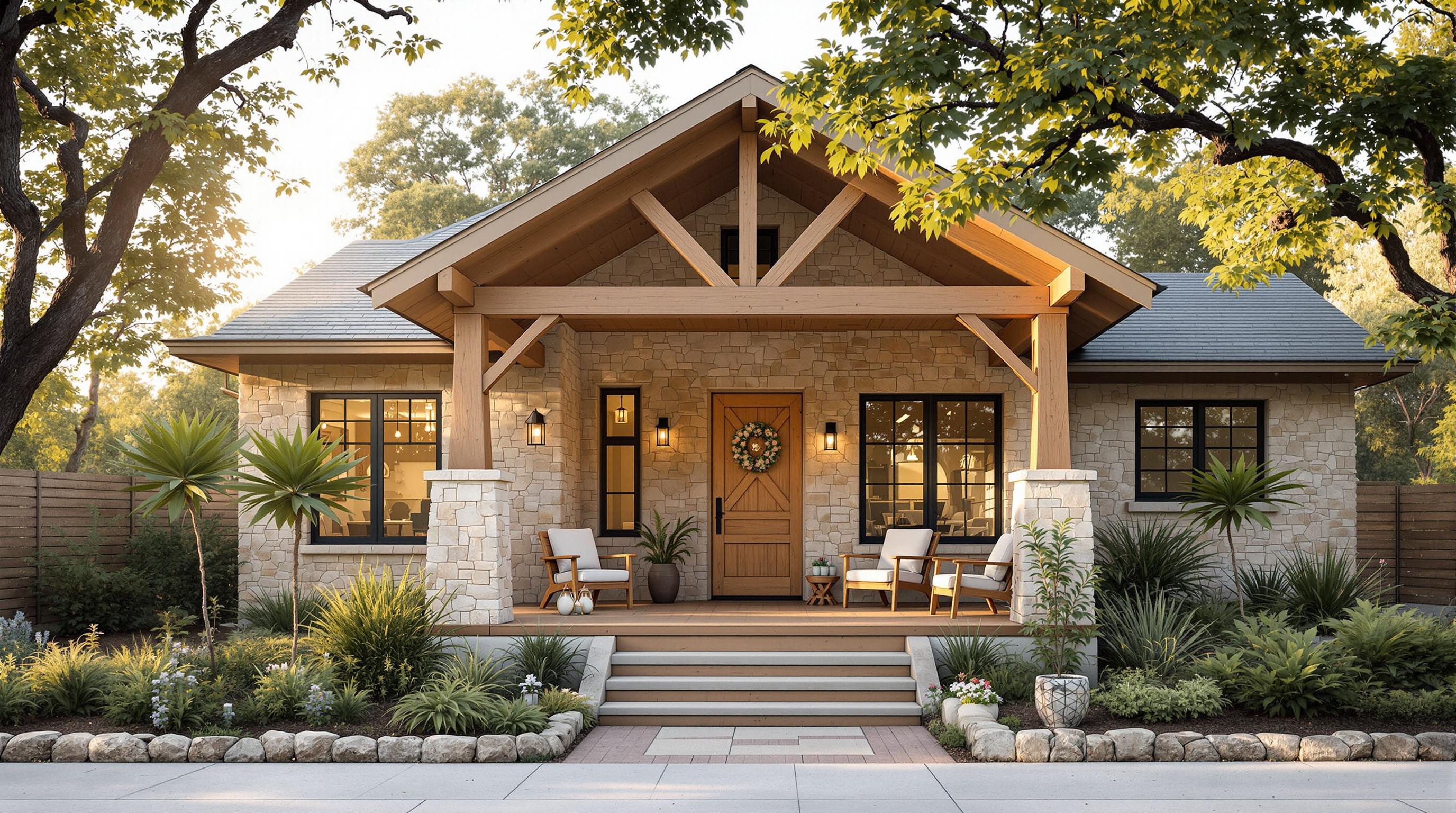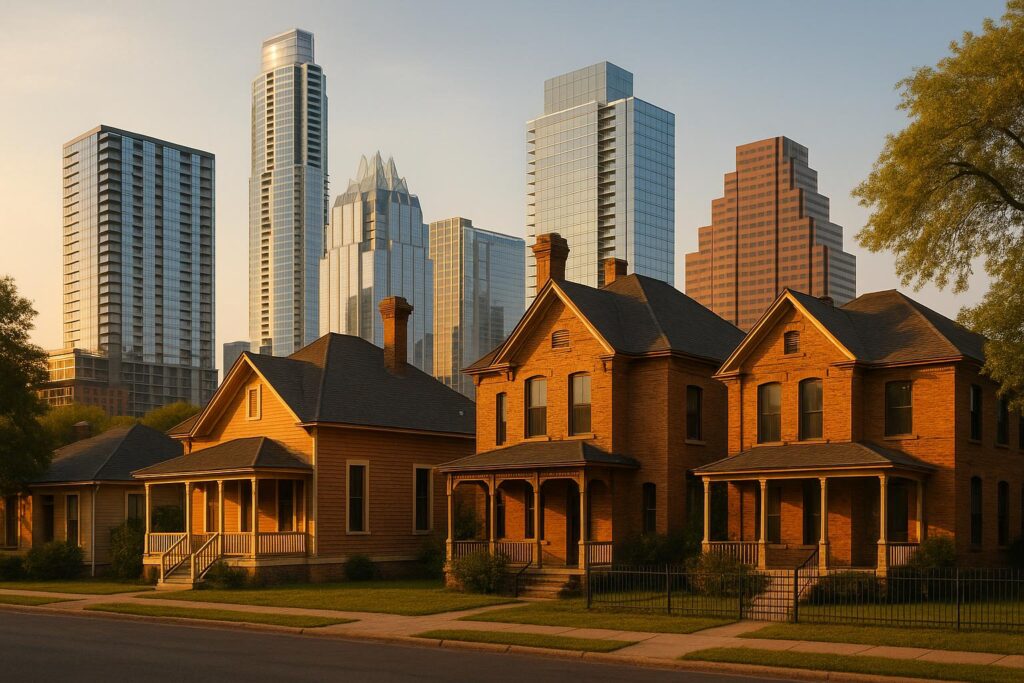Austin’s home styles are shaped by Hill Country design, combining local materials and climate-friendly features for comfort and style.
-
Key Features of Hill Country Design:
- Natural Materials: Limestone walls, cedar beams.
- Climate-Responsive: Deep overhangs, large windows, metal roofs.
- Indoor-Outdoor Connection: Covered patios, sliding doors.
- Eco-Friendly Additions: Rainwater systems, drought-resistant landscaping.
-
Other Popular Styles in Austin:
- Spanish Colonial & Mediterranean: Stucco walls, clay tile roofs, courtyards.
- Victorian & Queen Anne: Ornate woodwork, wrap-around porches.
- Craftsman & Bungalow: Limestone foundations, exposed beams.
- Ranch & Modern: Open layouts, solar panels, sleek designs.
Quick Comparison
| Style | Key Features | Drawbacks |
|---|---|---|
| Hill Country | Local materials, heat-resistant | Higher upfront costs |
| Spanish Colonial | Stucco, courtyards, Mediterranean charm | Weather wear, less flexible design |
| Victorian & Queen Anne | Ornate, historical charm | Expensive maintenance, less efficient |
| Craftsman & Bungalow | Space-efficient, natural materials | May need climate adjustments |
| Ranch & Modern | Open layouts, energy-efficient | Requires more space, less character |
Hill Country design stands out for blending practicality with local charm, making it a popular choice for Austin homes.
Galle Case Study: Custom Texas Hill Country Homes …
What Makes Hill Country Design
Hill Country design captures the rugged essence of central Texas through specific architectural features tailored to the area’s climate. In Austin, these classic traits blend with modern styles to create homes that are durable and reflective of the local culture.
Natural Materials and Textures
Hill Country homes often feature thick walls made from locally sourced limestone, which helps keep interiors cool during Texas’s intense summers. Exposed cedar beams not only add a rustic charm but also provide structural strength.
Climate-Responsive Architecture
These homes are designed with deep overhangs – typically 4 to 6 feet – to block direct sunlight during the hottest parts of the day while still allowing natural light to filter in during cooler hours. Large, floor-to-ceiling windows promote airflow and create a seamless connection between indoor spaces and the natural surroundings.
Distinctive Rooflines
Metal roofs, usually crafted from standing-seam galvanized steel or copper, are both practical and visually appealing. They reflect sunlight to minimize heat absorption and are built to last up to 50 years with proper care. The pitched design also ensures efficient water runoff during heavy rains.
Indoor-Outdoor Living Spaces
Covered porches and patios, often referred to as "dogtrot" passages, serve as transitional spaces between indoors and outdoors. These areas typically feature limestone floors and exposed wood-beamed ceilings, offering additional living space while shielding residents from the elements.
Eco-Friendly Features
Modern Hill Country homes often integrate sustainable elements such as:
- Rainwater collection systems
- Landscaping with native, drought-resistant plants
- Energy-efficient window placement
- Strategic orientation for natural cooling
These features naturally align with interiors that reflect the rustic charm of the region.
Interior Features
Inside, you’ll find open floor plans with ceilings soaring 10 to 12 feet high. Exposed trusses and beams further emphasize the home’s connection to nature. Stone fireplaces, often made from local limestone or river rock, act as striking focal points, stretching from floor to ceiling.
Together, these design elements create homes that are both functional and visually stunning, perfectly suited to Austin’s unique climate and landscape. While the style evolves, it remains rooted in its commitment to blending with the environment and honoring the region’s character.
1. Hill Country Homes
Hill Country homes in Austin are designed to blend indoor living with the beauty of the surrounding environment. These homes take inspiration from regional styles, combining classic design elements with modern touches to create spaces that feel both timeless and functional.
A common feature is the use of large sliding doors that open to patios or decks, creating a seamless connection between indoor and outdoor areas. This design not only allows for plenty of natural light but also stays true to the sturdy and practical style Hill Country homes are known for.
With a focus on connecting the indoors and outdoors, these homes reflect a way of life deeply tied to Austin’s unique landscape and climate.
2. Spanish Colonial and Mediterranean Houses
These European-inspired designs bring a touch of elegance to Austin’s architectural mix while incorporating Hill Country principles.
Spanish Colonial and Mediterranean homes blend effortlessly with the local environment, featuring stucco exteriors, clay tile roofs, and natural stone details. Their design and materials are well-suited for the region’s climate and aesthetic.
Materials and Construction
These styles are known for their stucco exteriors in earthy tones, complemented by clay tile roofs and stone accents. Thick walls help insulate the interiors, while wrought iron elements add character to windows, gates, and balconies.
Roof Design
The roofs are low-pitched or flat, often with wide eaves and terracotta tiles. This design not only defines the Mediterranean look but also provides shade and encourages ventilation.
Layout and Floor Plan
The homes often feature open layouts centered around a courtyard or patio. Arched doorways and windows allow for smooth transitions between rooms and invite plenty of natural light.
| Design Element | Spanish Colonial | Mediterranean |
|---|---|---|
| Wall Texture | Rough stucco finish | Smooth stucco finish |
| Window Style | Tall, narrow windows | Large, arched windows |
| Color Palette | Earth tones, white | Warm pastels, terra cotta |
| Exterior Courtyards/Patios | Interior courtyard | Multiple patios |
| Architectural Details | Heavy wooden doors | Ornate stonework |
Indoor-Outdoor Flow
These homes are designed to connect indoor and outdoor spaces seamlessly, using features like:
- Covered loggias and pergolas
- French doors leading to courtyards
- Mediterranean-style gardens with drought-tolerant plants
Weather Adaptation
Deep-set windows, shaded walkways, and well-placed outdoor areas help reduce exposure to the harsh Texas sun. Thick walls also improve energy efficiency by keeping interiors cooler.
These designs combine classic beauty with practical features, making them both stylish and functional for Austin’s climate.
sbb-itb-4c99469
3. Victorian and Queen Anne Buildings
Victorian and Queen Anne buildings in Austin blend traditional elegance with Hill Country practicality. These homes showcase intricate details while incorporating design elements suited to the local environment. The result is a unique architectural style that balances beauty and functionality.
Materials and Construction
These homes use a combination of traditional and locally sourced materials, including:
- Limestone and native stone for foundations
- Wood siding or shingles in decorative patterns
- Ornamental trim and detailed woodwork
- Wrought iron accents for railings and other features
These materials are paired with durable construction, ensuring both aesthetic appeal and structural integrity.
Roof Design
The roofs of these homes are a defining feature, with intricate designs that serve both form and function:
- Steep pitches with multiple gables
- Decorative shingles in varied patterns
- Prominent brick chimneys
- Wide eaves that provide shade
| Design Element | Victorian | Queen Anne |
|---|---|---|
| Exterior Finish | Mixed materials, often wood | Varied textures, multiple materials |
| Window Style | Tall double-hung windows | Bay windows, stained glass |
| Color Scheme | Deep, rich colors | Bold, contrasting colors |
| Porches | Wrap-around verandas | Asymmetrical porches |
| Architectural Details | Gingerbread trim | Turrets and towers |
Layout and Floor Plan
The interiors of these homes are thoughtfully designed, featuring:
- Formal room layouts with distinct spaces
- High ceilings, typically ranging from 10 to 12 feet
- Central hallways that allow for cross-ventilation
- Multiple fireplaces that add warmth and visual interest
Indoor-Outdoor Connection
These homes emphasize a strong connection to the outdoors with:
- Wrap-around porches that extend living spaces
- Multiple entry points to outdoor areas
- Covered galleries on upper floors
- Large windows that let in abundant natural light
Weather Protection
Designed to suit Austin’s climate, these homes include features like:
- Deep porches for shade
- Windows designed to optimize airflow
- Shading elements that reflect the period’s style
- Climate-conscious architectural details
4. Craftsman and Bungalow Houses
Craftsman and Bungalow houses in Austin blend Hill Country influences with classic architectural designs, resulting in homes that are both practical and visually appealing. These homes pay tribute to local materials while maintaining the timeless charm of their original styles.
Key features of Austin’s Craftsman and Bungalow homes include:
- Native limestone foundations, providing a sturdy and locally-inspired base.
- Exposed wooden beams paired with natural wood trim for a warm, rustic feel.
- Hand-crafted stonework showcasing detailed craftsmanship.
- Custom metalwork for fixtures and hardware, reflecting the period’s attention to detail.
- Cedar shakes or composition shingles with deep overhangs, offering both style and function.
5. Ranch and Modern Designs
Ranch and Modern homes in Austin stand out with roof designs that tackle the region’s climate challenges head-on. These homes prioritize both functionality and style, offering practical solutions for the area’s weather conditions.
| Feature | Benefit |
|---|---|
| Extended eaves | Adds shade during hot summers |
| Standing seam metal roofs | Reflects heat and lasts longer |
| Varied roof pitches | Improves rainwater collection |
| Integrated solar panels | Makes use of Texas’s abundant sunlight |
These design elements ensure that homes are better suited for Austin’s unique climate while maintaining a sleek, modern appearance.
Benefits and Drawbacks
Here’s a look at how Hill Country’s design approach stacks up against other popular regional styles in Austin:
| Home Style | Advantages | Drawbacks |
|---|---|---|
| Hill Country | Built for Austin’s heat, using local materials that ensure durability and keep interiors comfortable. | Higher upfront costs and may need specialized upkeep. |
| Spanish Colonial & Mediterranean | Showcases a regional flair with design elements that naturally improve thermal comfort. | Traditional materials can wear down faster in harsh weather and limit design flexibility. |
| Victorian & Queen Anne | Highlights ornate details and historical charm, adding to the home’s appeal. | Maintenance can be costly, and energy efficiency often falls short of modern standards. |
| Craftsman & Bungalow | Focuses on efficient space use and natural light, offering a functional and cost-conscious design. | May need further adjustments to fully suit Austin’s climate and lifestyle. |
| Ranch & Modern | Includes adaptable floor plans with room for energy-efficient upgrades, simplifying upkeep. | Requires more space and can lack the distinct character found in traditional styles. |
Hill Country designs stand out for their use of local materials and ability to stay cool under Austin’s intense sun. Modern enhancements, like better insulation, blend traditional strengths with newer building methods. However, these benefits often come with higher initial costs due to specialized techniques.
When selecting a home style in Austin, you’re balancing factors like climate adaptability, upfront expenses, maintenance needs, and long-term value. This comparison highlights the trade-offs that influence choices in the local housing market.
Summary
Hill Country design remains a key influence on Austin’s architecture, with new construction projects continually transforming the city’s skyline. For homebuyers, staying informed about these trends can make a big difference. The Austin Local Team provides expert insights to help buyers make well-informed decisions.





